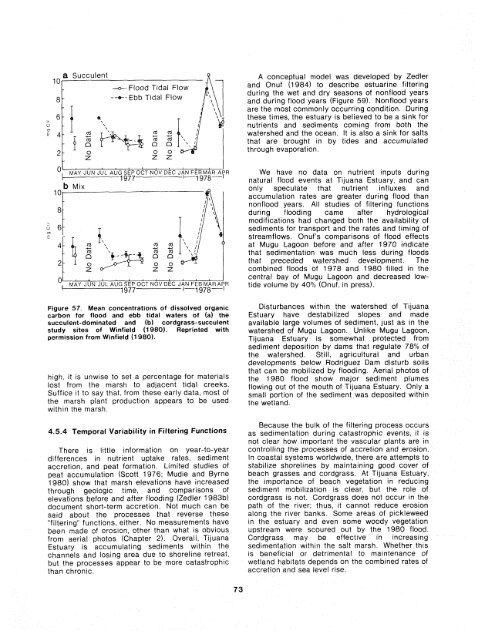The Ecology of Tijuana Estuary, California: An Estuarine Profile
The Ecology of Tijuana Estuary, California: An Estuarine Profile
The Ecology of Tijuana Estuary, California: An Estuarine Profile
Create successful ePaper yourself
Turn your PDF publications into a flip-book with our unique Google optimized e-Paper software.
a Succulent<br />
A conceptual model was developed by Zedler<br />
10<br />
--u- Flood Tidal Flow<br />
and Onuf (1984) to describe estuarine filtering<br />
during the wet and dry seasons <strong>of</strong> nonflood years<br />
8 - --*-Ebb Tidal Flow<br />
and during flood years (Figure 59). Nonflood years<br />
are the most commonly occurring condition. During<br />
these times, the estuary is believed to be a sink for<br />
\ nutrients and sediments coming from both the<br />
m m<br />
watershed and the ocean. It is also a sink for salts<br />
n n<br />
that are brought in by tides and accumulated<br />
through evaporation.<br />
2 - 0 0 0<br />
Z<br />
z z<br />
J<br />
O' M ~ J"N Y J~JL a& s b obr ~ baic v JAN F ~ B M am ~ R We have no data on nutrient inputs during<br />
1977 '---I 978-I<br />
natural flood events at Tiiuana <strong>Estuary</strong>, and can<br />
only speculate that nutrient influxes and<br />
accumulat~on rates are greater during flood than<br />
nonflood years. All studies <strong>of</strong> filtering functions<br />
during flooding came after hydrological<br />
modifications had changed both the availability <strong>of</strong><br />
sediments for transport and the rates and timing <strong>of</strong><br />
streamflows. Onuf's comparisons <strong>of</strong> flood effects<br />
at Mugu Lagoon before and after 1970 indicate<br />
that sedimentation was much less during floods<br />
that preceded watershed development. <strong>The</strong><br />
combined floods <strong>of</strong> 1978 and 1980 filled in the<br />
central bay <strong>of</strong> Mugu Lagoon and decreased low-<br />
R tide volume by 40°/0 (Onuf, In press).<br />
s 6 i f ?,<br />
' 4 - ng ++in" 2<br />
Figure 57. Mean concentrations <strong>of</strong> dissolved organic<br />
carbon for flood and ebb tidal waters <strong>of</strong> (a) the<br />
succulent-dominated and (b) cordgrass-succulent<br />
study sites <strong>of</strong> Winfield (1980). Reprinted with<br />
permission from Winfield (1 980).<br />
high, it is unwise to set a percentage for materials<br />
lost from the marsh to adjacent tidal creeks.<br />
Suffice it to say that, from these early data, most <strong>of</strong><br />
the marsh plant production appears to be used<br />
within the marsh.<br />
4.5.4 Temporal Variability in Filtering Functions<br />
<strong>The</strong>re is little information on year-to-year<br />
differences in nutrient uptake rates, sediment<br />
accretion, and peat formation. Limited studies <strong>of</strong><br />
peat accumulation (Scott 1976; Mudle and Byrne<br />
1980) show that marsh elevations have increased<br />
through geologic time, and comparisons <strong>of</strong><br />
elevations before and after flooding (Zedler 1983b)<br />
document short-term accretion. Not much can be<br />
satd about the processes that reverse these<br />
"filtering" functions, either. No measurements have<br />
been made <strong>of</strong> erosion, other than what is obvious<br />
from aerial photos (Chapter 2). Overall, <strong>Tijuana</strong><br />
<strong>Estuary</strong> is accumulating sediments within the<br />
channels and losing area due to shoreline retreat,<br />
but the processes appear to be more catastrophic<br />
than chronic.<br />
Disturbances wlthln the watershed <strong>of</strong> <strong>Tijuana</strong><br />
<strong>Estuary</strong> have destabilized slopes and made<br />
available large volumes <strong>of</strong> sediment, just as in the<br />
watershed <strong>of</strong> Mugu Lagoon. Unlike Mugu Lagoon,<br />
<strong>Tijuana</strong> <strong>Estuary</strong> is somewhat protected from<br />
sed~ment deposrtion by dams that regulate 78% <strong>of</strong><br />
the watershed. Still, agricultural and urban<br />
developments below Rodriguez Dam disturb soils<br />
that can be mobilized by flooding Aerial photos <strong>of</strong><br />
the 1980 flood show major sediment plumes<br />
flowing out <strong>of</strong> the mouth <strong>of</strong> <strong>Tijuana</strong> <strong>Estuary</strong>. Only a<br />
small portion <strong>of</strong> the sediment was deposited within<br />
the wetland.<br />
Because the bulk <strong>of</strong> the filtering process occurs<br />
as sedimentatlon during catastrophic events, it is<br />
not clear how important the vascular plants are in<br />
controlling the processes <strong>of</strong> accretion and erosion.<br />
In coastal systems worldwide, there are attempts to<br />
stabilize shorelrnes by maintaining good cover <strong>of</strong><br />
beach grasses and cordgrass. At <strong>Tijuana</strong> <strong>Estuary</strong>,<br />
the ~mportance <strong>of</strong> beach vegetation in reducing<br />
sed~ment mobilization is clear, but the role <strong>of</strong><br />
cordgrass is not. Cordgrass does not occur In the<br />
path <strong>of</strong> the rlver; thus, ~t cannot reduce erosion<br />
along the river banks. Some areas <strong>of</strong> pickleweed<br />
~n the estuary and even some woody vegetation<br />
upstream were scoured out by the 1980 flood.<br />
Cordgrass may be effectlve in increasing<br />
sedimentatlon within the salt marsh. Whether this<br />
IS beneficial or detrimental to maintenance <strong>of</strong><br />
wetland habitats depends on the comblned rates <strong>of</strong><br />
accretion and sea level rise.

















